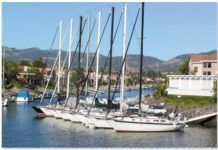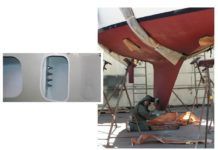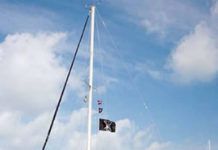Island Trader 37/38
In profile, the Island Trader 37 looks like she caught a wave on the chin. The sheer seems exaggerated, rising too high in the bow and stern. The low-aspect rig is short, carrying just 567 square feet of sail on a 30' 4" waterline. Displacement is reported anywhere from 18,600 lbs. to 26,400 Lbs. This gives the 37 an incredible displacement/length ratio of 422, and an abominable sail area/displacement ratio of 10.7, easily putting it in the "heavy" or "motorsailer" category.
Allied Princess 36
When you first see this boat, either in the water or on paper, the two things that immediately strike you are the sheer and bow. Edmunds put the low point of the sheer at the right place, about two-thirds of the distance aft from the bow. But the bow seems awfully high. In fact, when you walk forward along the sidedecks, you have the definite sensation of walking uphill. Too much, we think, though the look certainly sets the Princess apart from boats with flatter sheers (again, the Pearson 365 comes to mind).
CS 36
The CS 36, despite its small, reverse counter transom, still looks fairly modern today, with its rakish bow, low-profile cabin and tall, singlespreader rig.
Bristol Channel Cutter, Morris 40, Alerion Sloop
The Alerion Sloop, Bristol Channel Cutter and Morris 40 cover the range from gentleman's daysailer to blue-water passagemaker. Each is of superior design and construction-it's nice to know you can still buy quality, but you'd better have deep pockets.
The Modern Classic Racer-Cruiser
The Islander 36 was built from 1971 to 1985, making it one of the longest-lived 36-footers ever on the U.S. market. More than 750 of the Alan Gurney-designed racer-cruiser sloops were built, with production spanning almost the entire history of Islander Yachts.
Age Calls for Close Inspection
The Islander 36 is a fairly light-displacement boat. The hand-laid hull is an uncored, single skin, with polyester resin and fiberglass furniture components adding rigidity. The hull and plywood-core deck are bolted together at close intervals through an aluminum toerail.
Heavy Glass Hull Marks Tayana 37 Boat
The hull of the Tayana 37 is a fairly heavy, solid-glass layup. Some roving print-through is evident in the topsides. In the past, the hull-to-deck joint has occasionally been a problem. There is no doubt it is strong, but there have been numerous reports of leaking.
Island Trader 37/38
During the late 1970s, when Taiwan-built boats began to appear on the U.S. market in in creasing numbers, few boats better illustrated the Far East yacht than the Island Trader 37 or 38. (Same boat, different name depending on which brochure, in which year, you read.) Imported to the U.S. by Marine International of Bay Head, New Jersey, between about 1977 and 1988, the Island Trader line apparently embodied the general misconception of what a real…
Dissecting the CSY 37
Designed by Peter Schmitt, the CSY 37 is the mid-sized boat in the CSY line. Eighty-seven of these raised-deck cutters were built, primarily for the Caribbean bareboat charter trade. Schmitt has combined some features most often found in traditional boats-the oval stem, raised deck, and semi-clipper bow-with a relatively modern underbody featuring a fairly long fin keel and a skeg-mounted rudder. On paper, the boat looks pretty good. In person, she is rather tubby and high-sided, but that tubbiness means added buoyancy-not such a bad thing to have in a blow.
Heavy-duty Hull Gets High Praise
With more than three decades of hard use behind it-first in the charter trade and later in private ownership-the CSY 37 has very few secrets. All its warts are well exposed; as are its strengths. About two-dozen current and former owners responded to our survey, and we saw many consistencies in their comments. Most owners praised the boats rugged construction and stability and lamented its upwind performance. On the whole, the boat delivered what they expected of a cruising boat: namely a boat that would get them (and a fair amount of gear and provisions) safely and comfortably to their destination. Nearly all of the respondents had the owners version or B layout, and praised its livability. The following summaries and comments are representative of the majority of responses we collected.














































